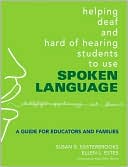List Books » Helping Deaf and Hard of Hearing Students to Use Spoken Language: A Guide for Educators and Families
Category Books
- Fiction Books & Literature
- Graphic Novels
- Horror
- Mystery & Crime
- Poetry
- Romance Books
- Science Fiction & Fantasy
- Thrillers
- Westerns
- Ages 0-2
- Ages 3-5
- Ages 6-8
- Ages 9-12
- Teens
- Children's Books
- African Americans
- Antiques & Collectibles
- Art, Architecture & Photography
- Bibles & Bible Studies
- Biography
- Business Books
- Christianity
- Computer Books & Technology Books
- Cookbooks, Food & Wine
- Crafts & Hobbies Books
- Education & Teaching
- Engineering
- Entertainment
- Foreign Languages
- Game Books
- Gay & Lesbian
- Health Books, Diet & Fitness Books
- History
- Home & Garden
- Humor Books
- Judaism & Judaica
- Law
- Medical Books
- New Age & Spirituality
- Nonfiction
- Parenting & Family
- Pets
- Philosophy
- Political Books & Current Events Books
- Psychology & Psychotherapy
- Reference
- Religion Books
- Science & Nature
- Self Improvement
- Sex & Relationships
- Social Sciences
- Sports & Adventure
- Study Guides & Test Prep
- Travel
- True Crime
- Weddings
- Women's Studies
Helping Deaf and Hard of Hearing Students to Use Spoken Language: A Guide for Educators and Families » (1st Edition)

Authors: Susan Easterbrooks, Ellen L. Estes
ISBN-13: 9781412927338, ISBN-10: 1412927331
Format: Paperback
Publisher: SAGE Publications
Date Published: May 2007
Edition: 1st Edition
Author Biography: Susan Easterbrooks
Ellen L. Estes is the Coordinator of the Katherine Hamm Center, an auditory-oral program for children with hearing losses at the Atlanta Speech School (www.atlantaspeechschool.org). She has taught children with hearing losses for 30 years. She is a past-Chair of the International Professional Section of the Alexander Graham Bell Association for the Deaf and Hard of Hearing. She has written articles, conducted workshops, and advised schools throughout the country on many aspects of the language and literacy development of children who are deaf or hard of hearing. She resides in Powder Springs, Georgia with her children and two very bad dogs.
Book Synopsis
Based on the authors' model of auditory, speech, and language development, the book provides educators with effective techniques and strategies for working with children in the primary grades.
Table of Contents
Foreword (by Mary Ellen Nevins, EdD)
Preface
Acknowledgements
About the Authors
Part 1: The Art of Intervention
1. Listening and Spoken Language Interventions: A Model and Activities for Helping Children
Listening Challenges That Children Must Overcome
Model of Auditory, Speech, and Language Development
Summary
2. Early Detection and Intervention for Infants and Toddlers
Early Detection and Intervention
Necessary Services for Infants, Toddlers, and Their Families
How Listening Develops in Infants and Toddlers
How Infants Develop Spoken Language
How Toddlers Develop Spoken Language
Interventions for Babies
Applying the Model With Babies
Interventions for Toddlers
Applying the Model With Toddlers
If a Child Is Not Making Measurable Progress
The Need for Flexible Models
Summary
3. Intervention for Preschoolers
Collaborating With Service Providers
What You Need to Know About a Child's Hearing Loss
What You Need to Know About Previous Intervention
What You Need to Know About Listening Technology
What You Need to Know About a Child With No Prior Services
Planning and Implementing Instruction and Interventions
Factors to Consider When Planning Lessons
Techniques to Use When Conducting a Lesson
Interventions for Preschoolers
Applying the Model With Preschoolers
Summary
4. Interventions for Children in the Primary Grades
A Typical Day in the Life of the Young Student With a Hearing Loss
The Effects of Hearing Loss in the Classroom
Assessing a Child's Present Levels of Performance
The Multidisciplinary Team of Professionals Who CanAssist the Teacher
Readiness for School
Instructional Considerations
Interventions for Children in the Primary Grades
Applying the Model With Kindergartners and Early Elementary Children
Summary
5. Developing Literacy Skills in Children With Hearing Losses
Learning to Read
Effective Approaches to Reading
Using Reading to Develop Language - A Paradox
Assessment
Implications for the Special Education Teacher
Implications for the General Education Teacher
Intervention
The Literacy Team
Summary
Part 2: The Science of Intervention
6. How Children Hear and Talk: Fundamentals of Listening and Speaking
The Speech Chain
Linguistic Level
Physiological Level: The Physiology of Speech
Physiological Level: The Physiology of Hearing
Acoustic Level
Hearing Aids, Cochlear Implants, and Assistive Listening Devices
Classroom Acoustics - Increasing the Child's Ability to Hear and Understand the Teacher and Peers
Daily Device Monitoring: Your Responsibility
How to Give the Ling Sound Check
Summary
Resource A: Organizations and Agencies Serving Children With Hearing Losses
Resource B: Assessments
Resource C: Sound-Object Associations (by Ellen A. Rhoades, EdS)
Resource D: Commercially Available Curriculum Guides and Materials
References
Index
Subjects
 Special Education
Special Education  Education - Hearing Impairments
Education - Hearing ImpairmentsEducation & Teaching
 Special Education
Special Education  Education - Physical Disabilities
Education - Physical DisabilitiesMedical Books
 Health-Related Professions
Health-Related Professions  Audiology & Speech Pathology
Audiology & Speech PathologyMedical Books
 Medicine
Medicine  Clinical Medicine
Clinical MedicineParenting & Family
 Children with Special Needs
Children with Special Needs  Hearing Impairments
Hearing ImpairmentsNonfiction
 Medicine
Medicine  Health-Related Professions
Health-Related ProfessionsNonfiction
 Medicine
Medicine  Medicine
Medicine
